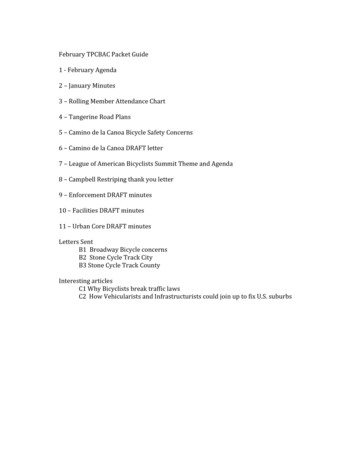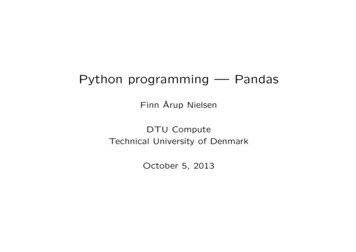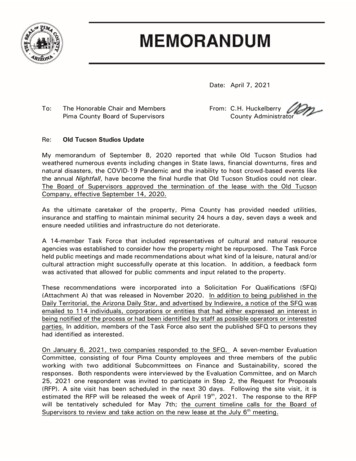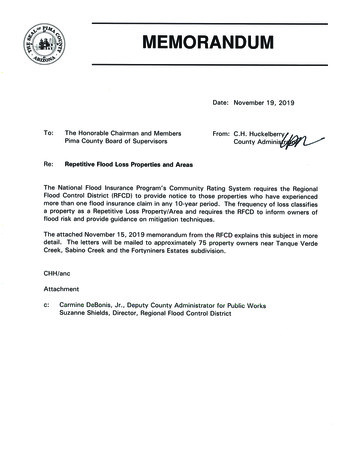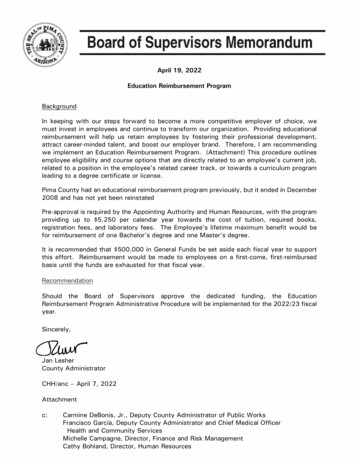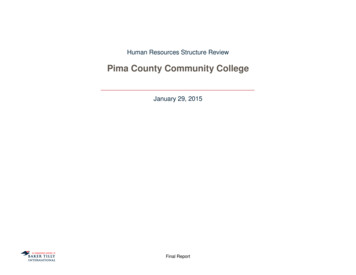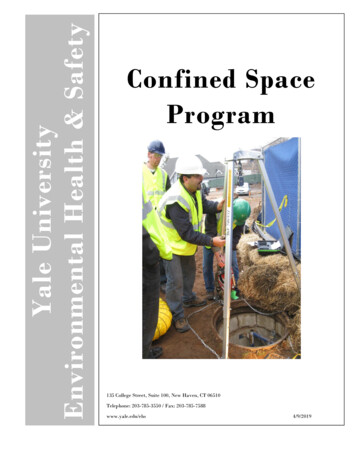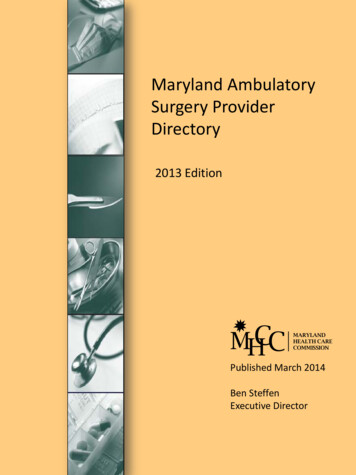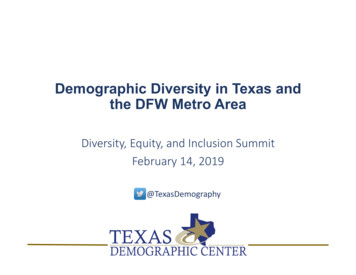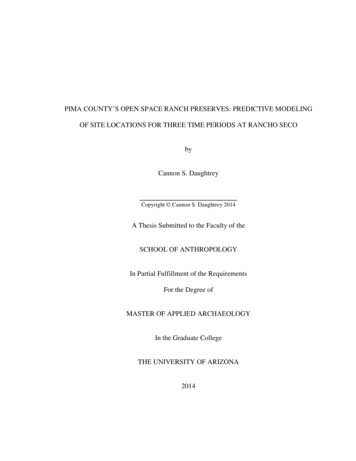
Transcription
PIMA COUNTY’S OPEN SPACE RANCH PRESERVES: PREDICTIVE MODELINGOF SITE LOCATIONS FOR THREE TIME PERIODS AT RANCHO SECObyCannon S. DaughtreyCopyright Cannon S. Daughtrey 2014A Thesis Submitted to the Faculty of theSCHOOL OF ANTHROPOLOGYIn Partial Fulfillment of the RequirementsFor the Degree ofMASTER OF APPLIED ARCHAEOLOGYIn the Graduate CollegeTHE UNIVERSITY OF ARIZONA2014
STATEMENT BY AUTHORThis thesis has been submitted in partial fulfillment of requirements for anadvanced degree at the University of Arizona and is deposited in the University Libraryto be made available to borrowers under rules of the Library.Brief quotations from this thesis are allowable without special permission,provided that an accurate acknowledgement of the source is made. Requests forpermission for extended quotation from or reproduction of this manuscript in wholeor in part may be granted by the copyright holder.SIGNED: Cannon S. DaughtreyAPPROVAL BY THESIS DIRECTORThis thesis has been approved on the date shown below:Dr. T.J. FergusonProfessor of AnthropologyApril 18, 2014Date2
ACKNOWLEDGEMENTSFirst, thank you to my committee members Dr. T.J. Ferguson, Dr. Courtney Rose, andDr. Paul Fish, without your guidance and reassurance I surely would have floundered. ToNahide Aydin and Matt Reynolds, thank you for all the Sundays spent at your homemulling this over. To Dr. Gary Christopherson, Rick Karl, and the staff of AZSITE, thankyou for your technical expertise, thoughtful insight, and for the data necessary tocomplete this project. For Dr. M. Nieves Zedeño, thank you for taking a chance on me.To Rita Sulkosky, thank you for helping with those final touches. To all my dear friends,my family, and my colleagues, thank you for believing in me, and teaching, inspiring,and supporting me through the years. Without you in my life, I’d have very little. Lastly,I’d like to extend my thanks to the staff of Pima County’s Office of CulturalSustainability. You all are preeminent scholars and visionaries.3
DEDICATIONTo all the souls lost at sea.4
TABLE OF CONTENTSACKNOWLEDGEMENTS . 3DEDICATION . 4TABLE OF CONTENTS . 5LIST OF FIGURES . 8LIST OF TABLES . 9ABSTRACT. 10CHAPTER ONE: MODELING SITE LOCATIONS ON PIMA COUNTY RANCHPRESERVES . 11Sonoran Desert Conservation Plan and Open Space Ranches . 13SDCP Predictive Models . 13Significance of Research . 14Physical and Environmental Settings . 16Theory of Predictive Modeling . 18CHAPTER TWO: ARCHAEOLOGICAL BACKGROUND . 24Cultural Overview . 24Preceramic Period (12,000 B.C.-A.D. 200) . 24Ceramic period (A.D. 200-1540) . 25Historic period (A.D. 1540-1950) . 27Classification of Archaeological Sites in Eastern Pima County. 285
TABLE OF CONTENTS - ContinuedPrevious Archaeological Documentation at Rancho Seco . 30CHAPTER THREE: METHODS . 42Research Objective . 42Independent Predictor Variables . 44Methods for GIS Preprocessing . 48Methods for Statistical Analysis . 52CHAPTER FOUR: ANALYSIS . 57Spatial Analyses of Probable Site Locations by Time Period in Southeastern PimaCounty. 57Results of Statistical Analyses . 59Preceramic Habitations (Model Formula) . 60Patterning of Preceramic Habitations at Rancho Seco . 61Preceramic All Other Sites (Model Formula) . 64Patterning of Preceramic All Other Sites at Rancho Seco . 64Ceramic Habitations (Model Formula) . 67Patterning of Ceramic Habitations at Rancho Seco . 67Ceramic All Other Sites (Model Formula) . 70Patterning of Ceramic All Other Sites at Rancho Seco . 70Historic Habitations (Model Formula) . 736
TABLE OF CONTENTS - ContinuedPatterning of Historic Habitations at Rancho Seco . 73Historic All Other Sites (Model Formula) . 75Patterning of Historic All Other Sites at Rancho Seco . 77SDCP Expert-Opinion Predictive Models and Quantitative Models . 80Results: Local Settlement Pattern Studies at Rancho Seco Based on Southeastern PimaCounty Site Type Signatures . 84CHAPTER FIVE: CONCLUSIONS . 86Future Management and Research-Oriented Data Collection . 86Differences in the Rancho Seco Landscape and the Study Area . 87The Problems of Typological and Sampling Biases . 89Prospective Research . 90APPENDIX . 93Appendix A: Field Calculator Scripts Coding Binary Site Types into Feature Classesfor Spatial and Statistical Analyses . 93REFERENCES CITED . 947
LIST OF FIGURES1: Discontinuous parcels of the Rancho Seco Study Area and Watershed Divide . 122: Southeastern Pima County Study Area in relation to Rancho Seco . 173: Sites Buffered at 500 m on Rancho Seco Preserve . 334: Boulder with cupules at Indian Cave Site AZ DD:7:30(ASM) . 345: Historic features from USGS and GLO records . 416: Location of Random Points (Control Group) . 567: Preceramic Habitations Binary Model (0 Least Likely, 1 Most Likely) . 638: Preceramic All Other Sites Binary Model (0 Least Likely, 1 Most Likely . 669: Ceramic Habitations Binary Model (0 Least Likely, 1 Most Likely) . 6910: Ceramic All Other Sites Binary Model (0 Least Likely, 1 Most Likely). 7211: Historic Habitations Binary Model (0 Least Likely, 1 Most Likely) . 7612: Historic All Other Sites Binary Model (0 Least Likely, 1 Most Likely) . 7913: SDCP All Sites by All Time Periods Expert-Opinion Predictive Model . 8214: All Sites by All Time Periods Quantitative Model (Combination of Binary Models,0 Least Likely, 6 Most Likely) . 838
LIST OF TABLES1: Archaeological Projects on Rancho Seco . 362: USGS and GLO Findings . 383: Independent Predictor Variables (Distance Ranges) . 454: Results of Regression (Preceramic Habitations) . 625: Results of Regression (Preceramic All Other Sites) . 656: Results of Regression (Ceramic Habitations) . 687: Results of Regression (Ceramic All Other Sites) . 708: Results of Regression (Historic Habitations). 739: Results of Regression (Historic All Other Sites) . 7710: Overall Quantitative Model Performances . 899
ABSTRACTThe initiatives of open space conservation, as outlined in the Sonoran DesertConservation Plan, have been implemented through the purchase of nearly 65 thousandacres by Pima County. This land abuts sections of grazing leases held by state and federalagencies, forming largely unfragmented landscapes surrounding the city’s urban core.Much of the outlying acreage is rural historic working ranches, now managed as openspace conservation preserves. Ranches are landscapes of low-intensity impact, where thearchaeological record of centuries of human land use is well preserved. Much of the land,however, remains relatively unstudied. To refine spatial predictions of archaeologicallysensitive areas in southern Pima County, I use multivariate logistic regression to developpredictive models of probable archaeological site locations for three time periods atRancho Seco as a case study. Results suggest portions Rancho Seco might containadditional Preceramic and Historic cultural resources but additional data collection isneeded.10
CHAPTER ONE: MODELING SITE LOCATIONS ONPIMA COUNTY RANCH PRESERVESMuch of what is understood about archaeological landscapes in eastern PimaCounty is derived from cultural resource management projects in Tucson’s urban areas.Those areas, often rife with development, experience projects conducted in response tocompliance with Section 106 of the National Historic Preservation Act. The areassurrounding the city’s urban core remain relatively unstudied. Many outlying areas areworking ranches managed by Pima County as open space conservation preserves. Theseranches represent landscapes of low-intensity impact, where the archaeological record ofcenturies of human land use is well preserved.To assist Pima County with devising strategies for managing cultural resources oncounty-owned ranch preserves, I develop several predictive models of probablearchaeological site locations for three time periods in eastern Pima County, and applythese predictive models to Rancho Seco in the southern portion of the county as a casestudy (Figure 1). Predictive modeling provides a visual and statistical assessment of theenvironmental settings which occur at ranches and the probability of archaeological sitesbeing present in certain locations. The models I develop will aid Pima Countyadministrators in choosing survey parcels for future inventory and provide a refinedspatial analysis of expected cultural resources at Rancho Seco.11
Figure 1: Discontinuous parcels of the Rancho Seco Study Area and Watershed Divide12
Sonoran Desert Conservation Plan and Open Space RanchesThe Sonoran Desert Conservation Plan (SDCP) was adopted in 2000 as amultifaceted land management strategy using science-based planning (PCOSC 2013).The plan takes into consideration the correlation between growth and the depletion ofresources in the county, directing growth to areas with the least natural, historic, andcultural resource values. A county-wide comprehensive assessment of cultural resourceslocated within geographic planning units that follow watershed boundaries was presentedin Saving the Past for the Future (PCOCRHP 2000b). This report details known andpredicted cultural resources from the last 12,000 years and provides an analysis of theconservation potential of various county landscapes to guide resource protection andacquisition of conservation parcels to be managed as preserves. Ranch conservation wasidentified as a salient means of fulfilling county objectives for open space, and thepurchase of ranch preserves, those areas forming fairly unfragmented desert landscapes,began using county bond funds (PSOSC 2013).SDCP Predictive ModelsTo fill gaps in knowledge, Pima County assembled a panel of regional experts toqualitatively evaluate county-wide archaeological landscapes. This panel was asked todraft archaeological sensitivity maps that spatially represent areas where culturalresources would likely be encountered (PCOCRHP 2000b). The archaeologicalsensitivity maps were designed to reveal general patterns of land use and expected sitelocations based on the known patterning of all sites from all time periods in Pima County13
(PCOCRHP 2000b:5). One key variable in the maps was proximity to perennial water, anessential resource in arid desert regions (PCOCRHP 2000b:8-10). The zones wereultimately defined as broad-brushed areas of high, medium, and low archaeologicalsensitivity.Following the implementation of the SDCP, Pima County purchased Rancho Secoin 2005. Rancho Seco is a discontinuous 9,699 acre priority ranch preserve in the AltarValley and Upper Santa Cruz planning units. Although few perennial streams exist incounty-owned parcels, nearly all of its lands are defined as critical biological habitat(Freshwater 2005). However, this preserve is situated primarily within a zone of low-tomedium archaeological sensitivity. While its physiographic attributes suggest a richarchaeological history is probably present, only one percent of the property has beensystematically investigated (Table 1; Hesse 2005; Doak 2011). There are nine knownarchaeological sites within the county-owned portion of the ranch, including prehistoricNative American habitations, resource procurement locales, rock art, ranch enterprises,and Spanish Colonial and Mexican period mines (Freshwater 2005; Hesse 2005). Countymanagers need more information to effectively manage cultural resources and designfuture inventory efforts while continuing sustainable ranch use.Significance of ResearchThe goals of my thesis research are to provide Pima County administrators withseveral refined quantitative models of areas likely to contain archaeological site locationsat Rancho Seco. By using available literature, selected geospatial datasets, and14
archaeological site locations in Pima County, I build six predictive models that indicatethe probable distribution and location of archaeological habitations and all other sitetypes for three time periods. I use well-studied proxy archaeological landscapes withenvironmental features comparable to county-owned ranch preserves and apply theresulting predictive values to Rancho Seco. Values are calculated through the use oflogistic regression and are expressed as a binary probability surface indicating those areasleast likely and most likely to contain archaeology. These ranges represent a combinationof environmental variables that are highly correlated with the locations of different typesof archaeological sites. The resulting models use a broad temporal context to profferexpected site locations within variable environments at the intraregional scale of analysis.The models also offer insight into possible systemic or cultural landscapes asarchaeological materials evidence empirically understood yet generalized humanbehaviors. For predictive formulas to be accurate, a large population must be sampled toformulate models and interpret results at a smaller scale on ranch preserves.Consequently, site type models for the Preceramic (12,000 B.C.-A.D. 200), Ceramic(A.D. 200-1540), and Historic (A.D. 1540-1950) periods are built for southeastern PimaCounty and then applied to Rancho Seco. Temporal designations follow the SDCP(PCOCRHPa).My research assumes that archaeological site locations are patterned in easternPima County, and that patterns extrapolated by assessing the relationship between sitelocations and their environmental settings can be applied to understudied regions tounderstand or posit variable land use. This research also assumes landscape preference,15
modification, and use through time might also be culturally patterned and that this patternmay become evident through the development and critical assessment of regional models.This information will be useful for county managers, cultural resource professionals, andacademicians interested in the semidesert grasslands surrounding Tucson, those areasalso assumed to be marginalized or along a cultural periphery (PCOCRHP 2000a:17-27;AWET 2000, 2001).Physical and Environmental SettingsMy predictive models are created using data from the Tucson Basin andsurrounding areas in southeastern Pima County (Figure 2). Pima County is located withinthe Basin and Range physiographic province of the southwestern United States, withinthe Sonoran Desert biome. This area is characterized by broad alluvial valleys separatedby linear mountain ranges that sharply rise from valley floors (Scalero et al. 2001:4).Rancho Seco is within the southern Altar Valley and western Upper Santa Cruzwatershed planning units (Figure 1 and Figure 2). Flanked by high mountains on eitherside, the Altar Valley is a narrow watershed containing the Altar Wash which flowsnorthward from the Mexican border. The Upper Santa Cruz watershed is bordered by theTumacácori Mountains in the west and contains the northward flowing Santa Cruz River.16
Figure 2: Southeastern Pima County Study Area in relation to Rancho Seco17
Although the geology of the Altar Valley and Upper Santa Cruz are similar to thatof eastern Pima County, the topographic relief of western Rancho Seco is more extremebecause portions of the preserve are located in the Las Guijas Mountains and nearby theCerro Colorado Mountains. Also, the floodplains of eastern Rancho Seco in the UpperSanta Cruz watershed are not as broad as those of the middle and lower valley, andperennial water sources are less reliable. However, groundwater is shallow throughoutand there are numerous springs on and surrounding the preserve that support riparianhabitats. The Altar Wash, also known as Brawley Wash, and its tributaries are located tothe west of Rancho Seco. Arivaca Creek, one such tributary is a significant riparian areasouth of the preserve. Sopori Wash, a tributary of the Santa Cruz River, is located in theeast portion of the preserve and is partially within Rancho Seco’s bounds. Soil formationin areas of Rancho Seco is described as silt, sand, gravel and cobbles on alluvial plainsresulting from canyon-cutting flash floods and mudflows while Late Tertiary andPleistocene weathering has aided in the development of subsurface clays and calichehorizons on piedmonts (Bezy et al. 2007:6). Colluviation of some landforms is certainlyan ongoing process given the persistence of the cattle industry in the area. Elevationsrange from about 300 to 1370 meters above mean sea level. The climate of Rancho Secois semiarid and most of the preserve is located within the warm-temperate grasslandsregion (Brown 1994:122-131) whereas much of Pima County is within the upper Sonorandesertscrub region. Annual rainfall for the area was recorded at nearby Buenos AiresNational Wildlife Refuge as 41.4 cm (Bezy et al. 2007:6). Adaptive culturalmanifestations are undoubtedly affected by this environment. Given the diverse natural18
resources that are present at Rancho Seco, there is a high probability that the ranchcontains more archaeological sites than those currently known. However, nuanceddifferences between the environmental settings of southeastern Pima County and RanchoSeco may preclude models from quantifying or predicting all possibilities associated withan accurate reflection of Rancho Seco’s archaeological record.Theory of Predictive ModelingHuman adaptive systems follow patterns that become apparent when analyzingsettlement within certain environmental and social contexts. Having theoretical roots inhuman ecology, settlement systems theory, environmental archaeology, and landscapestudies (Butzer 1982; Crumley 1994; Judge and Sebastian 1988), the predictive modelingparadigm derives from Gordon Willey’s settlement archaeology coupled with NewArchaeology’s emphasis on quantitative methods (Verhagen and Whitley 2012:51).Building on Steward’s model of cultural ecology, which asserts that cultural and humanbiological adaptations are responsive to variable social and physical environmentalstimuli, Willey (1953) pioneered the concept of settlement systems studies during hiswork in the Viru Valley of Peru. Willey’s suggestion that human settlement locations arepatterned as a reflection of their position within, and knowledge of, a wider social andenvironmental landscape was the impetus for holistic approaches in studying pastcultures.Beginning in the 1960s, the New Archaeologists—now consideredprocessualists—turned their attention to settlement pattern studies with gusto. Influential19
work undertaken by the Southwestern Archaeological Research Group (SARG) focusedon identifying commonalities and variability in aspects of human activity locatingbehavior through a comparison of regional survey data. SARG centered the first stages ofits research on understanding the articulation between environment and colonizing humanactivities over specific geographies (Euler and Gumerman 1978:103). Areas underinvestigation included El Morro Valley, New Mexico; Chevelon Drainage, Arizona; andCedar Mesa, Utah; among others (Euler and Gumerman:1-102). Computer generatedmaps were used as an analytical tool to study the distributions of environmental, cultural,and temporal factors in these areas. The maps were further used to define possible useareas within these geographies (Euler and Gumerman 1978:152). The underpinnings ofcontemporary predictive modeling were born from SARG’S efforts. Predictive modelingdiscerns whether patterns are predictable by building statistical models that indicate thelikelihood of archaeological sites being present in particular landscapes (Mehrer andWescott 2006: 4). Predictive models are expressions of a probabilistic relationshipbetween human behavior and existing spatial conditions (Verhagen and Whitley 2012:71).Predictive modeling in archaeology became increasingly popular in the 1980s, andsince then a number of new elements have been added, including multiscalar settlementsystems studies, multivariate and univariate statistical analyses, and geographicinformation systems (GIS) to produce quantitative models of site location probabilitiesused for large-scale cultural resource management (Judge and Sebastian 1988; Kvamme1992a; Mehrer and Wescott 2006; Wescott and Brandon 2003). Two lines of research20
were identified in the formulation of early locational models (Kohler and Parker 1986;Verhagen and Whitley 2012:51). Largely theoretical, the first line of research resulted inmodels based on the use of ecosystemic structures and relationships used to identifyspatial suitability. However, these models lacked quantitative measures of spatial area(Jochim1976, 1981; Bettinger 1980). A second set of models, based on empiricalresearch, were created by extrapolating environmental variables in a quantitative fashionand creating correlative statistical summaries that were then applied in unsurveyed areas(Kvamme 1983, 1984, 1985; Parker 1985). Kohler and Parker (1986:400) consider thelatter type of models to be economic in that human behavior is assumed to rely on costeffective means of exploiting the environment, therefore environmental settings mightreflect the results of human exploitative behaviors and land use on a basic level.Characterized as empirical-correlative (Kohler and Parker 1986:402), these models werelater criticized (Kvamme 2006) for being atheoretical and for misinterpreting statisticalcorrelations between site locations and their physical environment as an effort to explainhuman behavioral choices involving site preference.Kvamme (2006:13) cautions that modelers “need to be clear whether [they] aretrying to model the systemic context or the archaeological context the former refers tothe living behavioral state of a human group or society. The latter refers to the static,nonbehavioral state of archaeological materials.” Empirical-correlative models typicallyquantify static elements of the environment and their relationship to the current state ofthe archaeological record. In further support of correlative modeling theory, Kvamme(2006:12) remarks that the “act of selecting variables for analysis demands an a priori21
theoretical perspective that comes from previous work, training, and exposure to thetheoretical currents of a discipline,” asserting distinct correlative approaches anddeductive approaches in modeling need not be different (Kvamme 2006:13).Whether this is true or not, a paradigmatic shift in predictive modeling producedwhat are termed deductive-explanatory models. These models rely on theories shaped bycognitive archaeology, environmental archaeology, human behavioral ecology, andlandscape studies (Verhagen and Whitley 2012; McEwan 2012; Rockman and Steele2003). Environmental archaeology (Reitz et al. 2008) recognizes strategies for resourceacquisition, nutrition and health, domestication, exchange systems, and emergent socialcomplexity as interpreted through human and environmental interaction. Principles oflandscape studies (Bowser and Zedeño 2009; Heilen 2005; Rockman and Steele 2003)explore the interrelationship between landscape cognition and landscape behavior citingontological meanings imbued in a landscape of culture, action, and agency. Followingthis discourse, deductive-explanatory models do not use site locations to offer correlativepredictions. Instead, deductive-explanatory models use the locations of sites to test spatialmodels developed from theoretical notions of human behavior and site locale preferencebased on cognitive choice. For example, Verhagen and Whitley (2012) use humanbehavioral ecology and cognitive archaeological approaches to model average caloric andreturned caloric landscapes along the Georgia coast to explain site locations and exploretheories related to emerging social change. They argue site locale selection reflectshuman choices possibly bound by expected caloric rate returns and cost paths. Adeductive modeling approach at Rancho Seco would be difficult to produce because of22
the paucity of survey coverage and the corresponding gaps in our knowledge about thearchaeological sites that exist in the area. Further survey and inventory of the preserve isneeded.Because of this lack of data, my research seeks to understand the archaeologicalcontext of Rancho Seco based on regional human-environmental patterns. Therefore I useempirical-correlative predictive models to identify probable locations of sites within thepreserve. Although inherently deterministic and influenced by the idea that humaneconomy relies heavily on the environment, empirical-correlative predictive modelsrecognize the relationship between human ecosystems and the physical-biological worldsthey inhabit. The interaction between independent environmental variables such as slope,aspect, elevation, soil type, vegetation cover, and distance to riparian zones, high biomasshabitats, and permanent water has consistently produced signatures predicting sitelocations (Kvamme 1999). Social and behavioral theory related to systemic activities canbe successfully applied when critically assessing the output of a correlative model(McEwan 2012) and correlative models should always be improved with physical testingand continued data collection.23
CHAPTER TWO: ARCHAEOLOGICAL BACKGROUNDCultural OverviewThe cultural and archaeological landscapes of Pima County are diverse implyingvariable system
Predictive modeling provides a visual and statistical assessment of the environmental settings which occur at ranches and the probability of archaeological sites being present in certain locations. The models I develop will aid Pima County administrators in choosing survey parcels for future inventory and provide a refined
